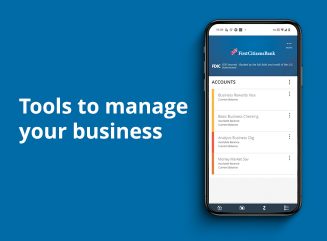Digital banking for business
Seamlessly access all of your accounts from one place with First Citizens Digital Banking for business.

Invest how you want, when you want, in real time with Self-Directed Investing.

Seamlessly access all of your accounts from one place with First Citizens Digital Banking for business.
We're committed to serving companies as they expand and succeed. The proof is in our success stories.
November Market Update video: Available now
Phillip and Blake take a deep dive into key issues for markets and the economy as we enter the holiday season.
The final months of the year offer a valuable opportunity to make strategic adjustments to your current and future tax planning. From charitable giving and Roth IRA conversions to leveraging trusts and business tax breaks, there are several tax-saving strategies high-income and high-net-worth individuals should consider before December 31.

With recent sweeping tax changes, thoughtful year-end tax planning is more important than ever. Many of the tax-planning strategies that follow can directly reduce your 2025 tax bill, while others can help position you for long-term tax efficiency. In either case, acting now may help preserve more of your wealth over time.
If you're planning year-end donations, giving in a tax-efficient way can boost your impact. This is because the timing and structure of your gifts can unlock valuable federal and state tax benefits—especially for high earners.
In 2025, itemizers can deduct up to 60% of their adjusted gross income, or AGI, for cash gifts and 30% for noncash assets. But starting in 2026, the One Big Beautiful Bill Act, or OBBBA, will limit deductions to amounts exceeding 0.5% of AGI and caps the benefit at 35% for those in the top tax bracket. As a result, higher-income donors may want to accelerate their giving before these changes take effect.
If you're subject to required minimum distributions, or RMDs, from an IRA—and you don't need that money for living expenses—you can donate up to $108,000 in 2025 directly to qualified charities through a qualified charitable distribution, or QCD. This amount is excluded from taxable income, offering a significant tax break even if you don't itemize. If filing jointly, each spouse can contribute up to $108,000 this year from their own IRA.
Donor advised funds, or DAFs, and foundations remain popular options among tax-savvy givers. A DAF provides an immediate deduction for contributions while allowing you to delay recommendations of grants to qualified charities as desired. Gifts to private foundations also qualify for upfront deductions but generally offer less flexibility in directing funds. Foundations also must distribute a minimum of 5% of net assets each year.
Roth IRA conversions prove most tax-efficient during lower-income years, such as the first year of retirement or when future tax rate considerations apply. Converting traditional IRAs or 401(k) accounts to Roth IRAs requires paying income tax on converted amounts in 2025 but provides tax-free growth and tax-free withdrawals thereafter.
Roth IRAs can be especially powerful for individuals using self-directed IRAs to invest in alternative assets like private equity, art and collectibles. Holding these assets in a Roth IRA can offer significant potential for long-term, tax-free appreciation.
A tax professional can help you evaluate the timing and impact of a Roth IRA conversion—including effects on your tax bracket, Medicare premiums and state tax obligations.
The end of the year is a good time to ensure you're claiming every deduction available to you, especially those that can significantly reduce your taxable income.
The cap for the State and Local Tax, or SALT, deduction has been temporarily raised to $40,000 per household, with adjustments for inflation over the next 4 years. This is a notable increase from the previous $10,000 cap.
Pass-through business owners can utilize an often-overlooked strategy to fully deduct state and local taxes paid through the company, bypassing the $40,000 SALT cap. This workaround, available in a majority of states, was preserved under the OBBBA and offers unlimited state tax deductions for eligible businesses.
Investment interest deductions allow you to deduct interest on loans used for stock purchases, bond investments, private fund investments and stock option exercises. The deduction equals your net investment income for 2025, requiring proper interest-tracing documentation to track loan proceeds.
Some higher-income taxpayers also use this deduction to supplement the mortgage interest deduction, which is still capped at interest on the first $750,000 of mortgage debt. This may involve a cash-out refinance to convert nondeductible mortgage interest into deductible investment interest, but because the strategy requires precise documentation and timing, it should be carefully coordinated with a CPA and financial advisor.
Reviewing Schedule 1 deductions as part of your year-end tax planning can also uncover meaningful savings. These above-the-line deductions reduce your AGI and can be claimed whether or not you itemize.
Common examples include deductions for contributions to a health savings account, the deductible portion of self-employment tax, premiums for self-employed health insurance, eligible IRA contributions, student loan interest and alimony payments negotiated prior to 2019. Beginning in 2025, a new deduction also allows individuals to deduct up to $10,000 in interest—but only for vehicles purchased in 2025 or later that undergo final assembly in the US.
The OBBBA preserved elevated estate tax-exemption levels—set at $15 million for individuals and $30 million for couples starting in 2026. Despite these permanently higher thresholds, trusts remain a key estate planning tool for high-net-worth individuals.
Irrevocable trusts are particularly effective in reducing estate tax exposure by removing assets from the taxable estate. Structures like grantor retained annuity trusts and spousal lifetime access trusts facilitate tax-efficient asset transfers while potentially preserving access to income.
With fewer individuals now falling under the estate tax threshold, the strategic role of trusts is evolving toward income tax efficiency. Well-structured trusts can support this goal by enabling the following strategies:
Working with qualified tax and estate advisors is essential. They can help you determine how trusts can best support your long-term wealth strategy.
Annual gifting remains one of the simplest and most effective ways to transfer wealth and reduce your taxable estate. In 2025, you can give up to $19,000 per recipient—or $38,000 for married couples—without triggering gift tax, thanks to the annual gift tax exclusion.
For example, you could fund a custodial account for a minor. You could also fund a traditional or Roth IRA with up to $7,000 per year in 2025, as long as the minor has at least that much in earned income.
Contributions to a 529 education savings plan also count toward the annual exclusion and can be front loaded with 5 years' worth of gifts—up to $95,000 per recipient in 2025—without triggering gift tax. Keep in mind that you must file an IRS Form 709 when super funding a 529 plan. General annual gifts of $19,000 or less don't require reporting on a gift tax return.
Gifting appreciating assets—such as real estate, shares in a family business or investments—can also be tax-efficient. Transferring these assets early shifts future growth out of your estate and into the hands of your beneficiaries.
In some cases, placing the assets in an irrevocable trust can provide even greater control, asset protection for your heirs and tax advantages.
The fourth quarter of the year is a good time to review your portfolio through a tax lens. The goal is to identify overlooked opportunities or red flags, including:
The end of the year is the perfect time to consider whether tax-loss harvesting may reduce your current tax liability. When selling a stock or mutual fund position, you may realize a capital loss and potentially deduct up to $3,000 of collective losses against ordinary income—the rest can be used against any capital gains realized in the year. Any unused capital losses could be carried forward into future years indefinitely, providing a valuable tax-management tool.
While tax-loss harvesting can be a useful strategy, keep these considerations in mind.
Individuals ages 60 to 63 in 2025 should consider maximizing retirement plan contributions before December 31 to benefit from the new super catch-up provision. Starting January 1, 2025, eligible workers can contribute the greater of $10,000 or 150% of the regular catch-up limit to an employer-sponsored plan.
For example, with 401(k) plans the standard 2025 catch-up limit for those 50 and older is $7,500, making the enhanced limit $11,250 for ages 60 to 63. Combined with the regular employee deferral limit of $23,500, it allows a potential total contribution of $34,750.
Coordinate with your plan administrator early to adjust contributions and secure the full benefit for the year.
If you're an entrepreneur, founder or early-stage investor, your tax situation may be even more complex. Incentive stock options, or ISOs, require careful timing to avoid alternative minimum tax, or AMT, triggers. If you're expecting income increases, consider ISO exercise timing in 2025 instead of 2026 to optimize long-term capital gains treatment and AMT management.
It's a good idea to consult a financial advisor about this strategy because equity compensation rules may change.
If you invested in or helped launch a qualified small business, you may be eligible for the QSBS capital gains exclusion—up to $15 million or 10 times your basis in the company, depending on your circumstances. There are strict requirements for the stock to qualify as QSBS and the amount of the tax exclusion varies, so be sure to bring up the issue with your financial advisor.
As part of an overall strategy, you may want to consult a financial advisor about adding private equity to your portfolio to capitalize on this unique, long-term tax break.
As 2025 comes to a close, you have a key opportunity to take action. Consulting a financial advisor can help ensure you're taking advantage of every tax break available.
Planning ahead for legislative and regulatory changes is also essential. For example, First Citizens offers time-sensitive bulletins on tax, election and legislative developments, as well as how they may affect your financial planning in 2026 and beyond.
Different tax-planning strategies and actions require the expertise of a variety of advisors. Let First Citizens help you build your advisory team and manage the communication to keep everyone aligned.


Nerre Shuriah
JD, LLM, CM&AA, CBEC® | Senior Director of Wealth Planning and Knowledge


Nerre Shuriah
JD, LLM, CM&AA, CBEC® | Senior Director of Wealth Planning and Knowledge


Ann Lucchesi
Senior Director
This material is for informational purposes only and is not intended to be an offer, specific investment strategy, recommendation or solicitation to purchase or sell any security or insurance product, and should not be construed as legal, tax or accounting advice. Please consult with your legal or tax advisor regarding the particular facts and circumstances of your situation prior to making any financial decision. While we believe that the information presented is from reliable sources, we do not represent, warrant or guarantee that it is accurate or complete.
Third parties mentioned are not affiliated with First-Citizens Bank & Trust Company.
Links to third-party websites may have a privacy policy different from First Citizens Bank and may provide less security than this website. First Citizens Bank and its affiliates are not responsible for the products, services and content on any third-party website.
The information provided should not be considered as tax or legal advice. Please consult with your tax advisor.
Your investments in securities and insurance products and services are not insured by the FDIC or any other federal government agency and may lose value. They are not deposits or other obligations of, or guaranteed by any bank or bank affiliate and are subject to investment risks, including possible loss of the principal amounts invested. There is no guarantee that a strategy will achieve its objective.
About the Entities, Brands and Services Offered: First Citizens Wealth® (FCW) is a registered trademark of First Citizens BancShares, Inc., a bank holding company. The following affiliates of First Citizens BancShares are the entities through which FCW products are offered. Brokerage products and services are offered through First Citizens Investor Services, Inc. ("FCIS"), a registered broker-dealer, Member FINRA and SIPC. Advisory services are offered through FCIS, First Citizens Asset Management, Inc. and SVB Wealth LLC, all SEC registered investment advisors. Certain brokerage and advisory products and services may not be available from all investment professionals, in all jurisdictions or to all investors. Insurance products and services are offered through FCIS, a licensed insurance agency. Banking, lending, trust products and services, and certain insurance products and services are offered by First-Citizens Bank & Trust Company, Member FDIC and an Equal Housing Lender icon: sys-ehl, and First Citizens Delaware Trust Company.
All loans provided by First-Citizens Bank & Trust Company and Silicon Valley Bank are subject to underwriting, credit and collateral approval. Financing availability may vary by state. Restrictions may apply. All information contained herein is for informational purposes only and no guarantee is expressed or implied. Rates, terms, programs and underwriting policies are subject to change without notice. This is not a commitment to lend. Terms and conditions apply. NMLSR ID 503941
For more information about FCIS, FCAM or SVBW and its investment professionals, visit FirstCitizens.com/Wealth/Disclosures.
See more about First Citizens Investor Services, Inc. and our investment professionals at FINRA BrokerCheck.

Treasury & Cash Management
Electronic Bill Presentment & Payment
Investment & Retirement Services
Community Association Banking
Equipment Financing & Leasing
Credit Cards
Merchant Services
Email Us
Please select the option that best matches your needs.
Customers with account-related questions who aren't enrolled in Digital Banking or who would prefer to talk with someone can call us directly.